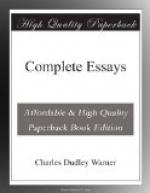When we criticise our recent fiction it is obvious that we ought to remember that it only conforms to the tendencies of our social life, our prevailing ethics, and to the art conditions of our time. Literature is never in any age an isolated product. It is closely related to the development or retrogression of the time in all departments of life. The literary production of our day seems, and no doubt is, more various than that of any other, and it is not easy to fix upon its leading tendency. It is claimed for its fiction, however, that it is analytic and realistic, and that much of it has certain other qualities that make it a new school in art. These aspects of it I wish to consider in this paper.
It is scarcely possible to touch upon our recent fiction, any more than upon our recent poetry, without taking into account what is called the Esthetic movement—a movement more prominent in England than elsewhere. A slight contemplation of this reveals its resemblance to the Romantic movement in Germany, of which the brothers Schlegel were apostles, in the latter part of the last century. The movements are alike in this: that they both sought inspiration in mediaevalism, in feudalism, in the symbols of a Christianity that ran to mysticism, in the quaint, strictly pre-Raphael art which was supposed to be the result of a simple faith. In the one case, the artless and childlike remains of old German pictures and statuary were exhumed and set up as worthy of imitation; in the other, we have carried out in art, in costume, and in domestic life, so far as possible, what has been wittily and accurately described as “stained-glass attitudes.” With all its peculiar vagaries, the English school is essentially a copy of the German, in its return




